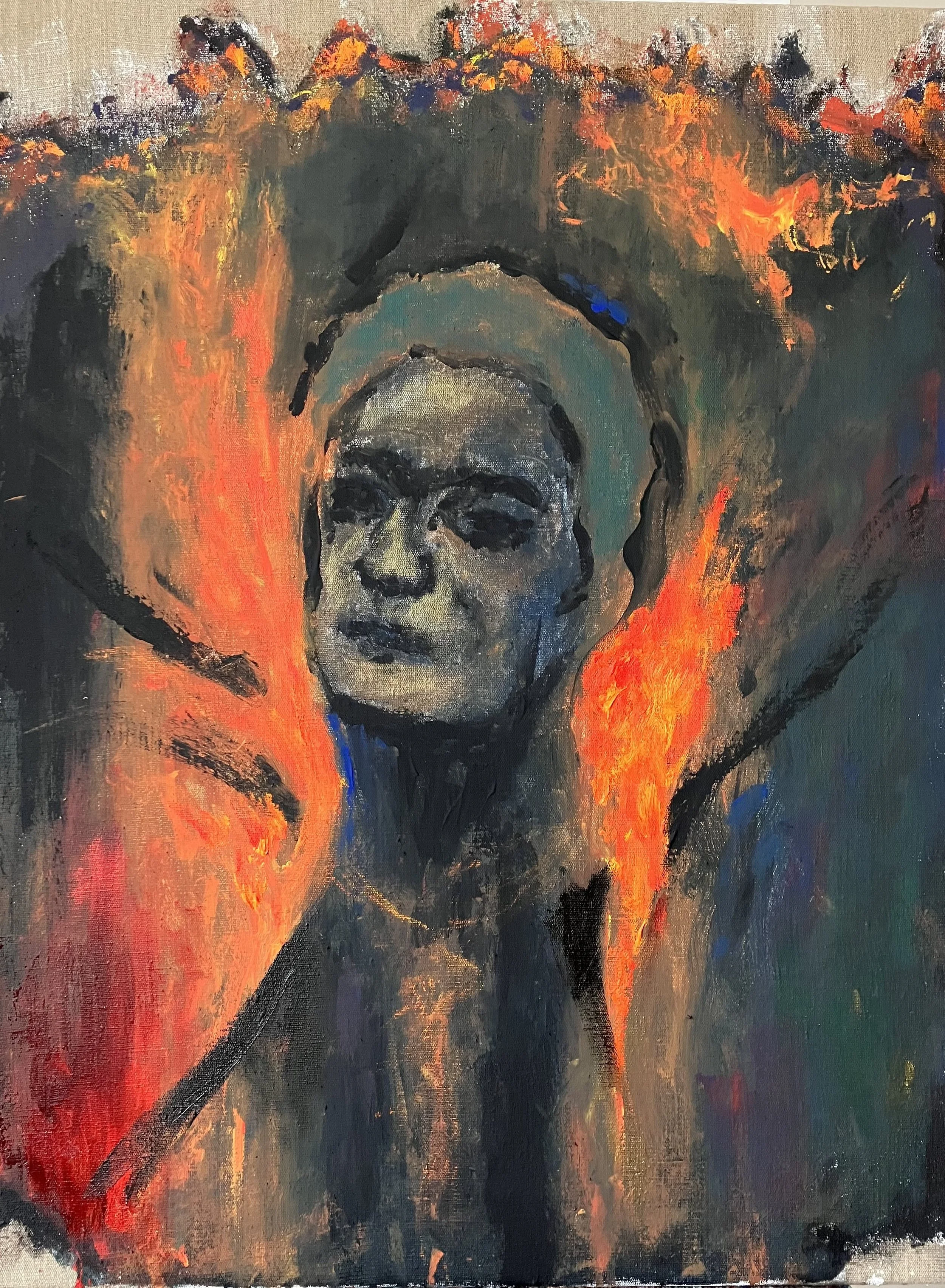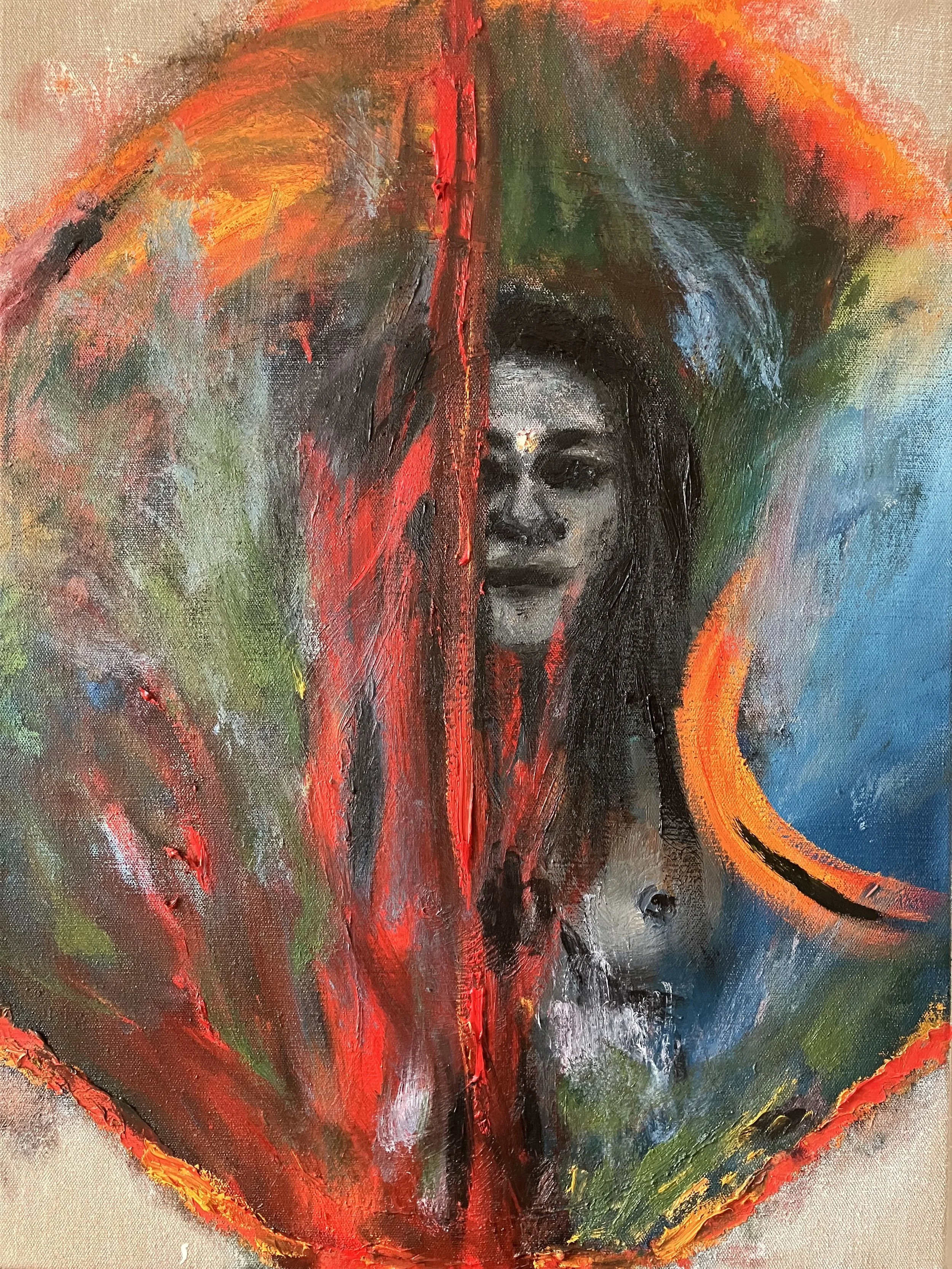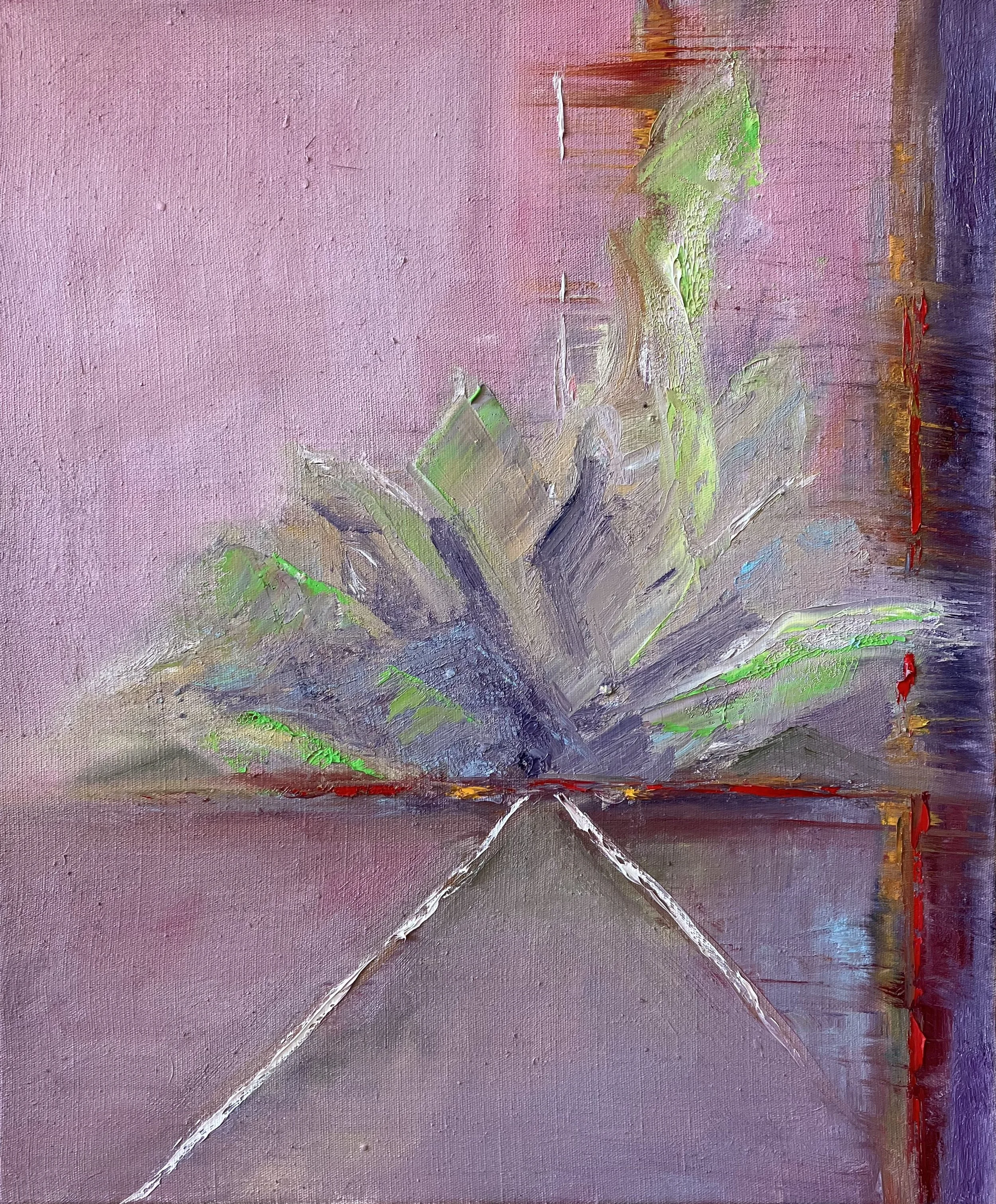10 Questions with Hana Šmidrkalová
Born in 1980, Hana Šmidrkalová is a Czech artist living and creating mostly in Prague. She studied law and became a full-time attorney. During her studies and later while doing law and business, she travelled with a backpack through a number of countries, some of which she stayed in longer and experienced many, many different cultures. Hana then began to travel more inward, connecting with her creative energy and spirituality. After her spiritual awakening, Hana began to paint full-time. She became an artist with strong expressionist tendencies and a passionate lover of painting. She is now studying under the guidance of the most prominent Czech painters to complement her formal education in painting and get a Master's degree in Fine arts. In addition to her art, she loves working with children with autism and enjoys supporting everyone on their unique journey to self-expression.
Hana Šmidrkalová - Portrait
ARTIST STATEMENT
“The most important element of the painting is Love.”
Hanaś work focuses mainly on exploring the sacredness of all that is and the transfer of this sacred essence onto the canvas. Her way of creating is free and not limited by the mind. In the creative process, she naturally gets into a state where her mind is not active, so she can be a channel for what she wants to be expressed. She brings both into her paintings, dynamics and delicacy, liveliness and calmness, connecting both poles and bringing the viewer with her to a state without duality, wherever he or she just is.
Portrait and figure are what interest Hana most as an artist; she often works in cycles, mainly in oils and acrylics, loves colours, and uses them both in their subtlety and in their full intensity.
Hana likes to discover, respect, and celebrate the uniqueness of each being, and it is this uniqueness that she tries to capture in her paintings. She strongly believes that through art, we can activate or develop the potential of being human, accepting, non-judgmental, and unconditionally loving and make the world a better place.
Raw. So what., Acrylic on paper, 100x66 cm, 2022 © Hana Šmidrkalová
INTERVIEW
First of all, you started as an attorney, before turning to painting. When did you first decide to become an artist, and how did you start experimenting with art?
I first started experimenting with art, or rather painting, about six years ago, when I first attended an evening painting class that was recommended to me by a friend. I signed up for the course and basically immediately went into a state of wonderful relaxation and deep meditation at the same time. I remember in the first class, we were drawing a figure of a ballerina from a photograph, and for me, the three hours of the course flew by in a second. I was amazed and happy at the same time! It was as if my soul remembered that it knew this intimately. After the drawing course, I took an acrylic painting course, a portrait and figure painting course, and an oil painting course. it was always once a week for three hours in a group of about ten students. After a while, I started painting on my own at home and started showing my paintings to friends, who gave me lovely feedback and were very supportive of my new journey. After a while, however, I found that group lessons no longer suited me, and I looked for ways to improve my own work under the individual guidance of an experienced teacher. And I found it. I enrolled in university, majoring in painting, and now I have been a student again for several years! (But at the same time, I continue to run my own business and also work with children with Autism). It was the moment of applying to university that I consider to be the "defining moment" when I realised that painting was my life, that "painting is me" and that it was actually quite easy to swap one career for another.
Rising, Mixed media on canvas, 80x60 cm, 2022 © Hana Šmidrkalová
What is your personal aim as an artist?
My goal is to create in accordance with my inner guidance, with sensitivity, and at the same time, with an intensity that can, if the viewer is open to it, catalyze changes and transformations in their lives. I am interested in asking unspoken questions through painting and allowing the viewer to find their own unique answers. If I were to define the most important themes of my work, they are: 1) the acceptance of the different-ness of each of us; 2) the exploration and integration of apparent contradictions; and 3) the exploration of what it means to be a woman in today's society, how to define femininity, what aspects of the role of women and femininity itself are accepted by society and what aspects are confrontational to society, how these themes are perceived outside of Euro-American culture, and how the above can be explored in terms of archetypes.
You are currently studying in Prague, what inspired you to go back to school and start all over?
I have found that my dream is to live a life where when the creative impulse comes, I can follow it and create. So it was clear to me that I needed to create a space for this to happen. After all, law and business are largely about executive action on behalf of clients and customers, where one is not the master of one's time, although, of course, creativity has its place in both of these areas. I decided to limit my executive activity as much as possible and start working step by step on my artistic career.
In transition, Mixed media on canvas, 80x60 cm, 2022 © Hana Šmidrkalová
INVITATION.NOW., Mixed media on canvas, 80x60 cm, 2021 © Hana Šmidrkalová
Your work revolves mostly around portraits. Where do you get inspiration for your work?
Often I approach people who carry some essence that I find interesting and paint according to the model. But I often paint without a model. In fact, you could say I paint fictional people. It is the "essence" of the person that interests me most, not so much his/her physical body. At the same time, I love to improve my figure and portrait painting so that even in expressive painting, the proportions of the body, perspective, and so on are correctly captured - I consider this a lifelong learning and a great joyful adventure as a painter.
In your statement, you also mention working in cycles. Can you tell us more about it? And how does it influence your work?
Yes, I will be happy to give some examples. One of the series, which includes 44 oil paintings, is a series on the theme of "Motherhood" where I worked with different aspects of the "Mother" and "Divine Mother" archetypes - the intention was to encourage women to connect with their inner Mother archetype and provide unconditional love, support, and nourishment to themselves. From these paintings, I then worked with the writer of the texts to co-create a card deck called the "Motherhood card deck" which is being sold and helps women connect with themselves. I am currently continuing to work on two major cycles. One is called "Adi Para Shakti" and is inspired by the so-called Shakti Peethas, which are important Hindu shrines and pilgrimage sites in the Himalayas focused on the worship of Adi Shakti, the primary divine feminine creative energy and force. This is very intense work, and I enjoy it immensely. I am primarily interested in figures painted in an expressive style in acrylic or oil and will include a total of 52 paintings (the same number as the number of Shakti Peeths). Another series I am creating is one dedicated to male sacred energy, which I capture mostly through portraits. This cycle has not yet been named. It now numbers ten paintings in which I use a great deal of color and will probably contain several dozen more. I feel very free in painting these works, and I would describe the process of creating these paintings as a "big bang".
Thankfully happy, Acrylic on paper, 100x66 cm, 2022 © Hana Šmidrkalová
What is your creative process like? And how did you evolve this way of working?
My creative process begins before I even pick up a brush, canvas, and paints for the first time. In fact, I would say that the most important phase of the creative process happens in the "unmanifest" space, the space outside of matter. If an impulse, a vision, a suggestion, or an idea (no matter what words we use to describe it) comes to me, I carefully observe whether the time has come to materialize it. If I start at the right time, the painting itself goes quickly - I like an expressive style of painting. With figures and portraits, I look for the right shape and proportions. I use colours very freely and don't really think about them at all. like when you can play a musical instrument, hear a melody, and play it straight away without notes (which I definitely can't do because I have no musical hearing). But the harmony in the tones and the mindless pressing of chords or keys. That's exactly what I experience when using colours. At the same time, if I make a mistake, it doesn't bother me - I can always repaint or modify the painting or part of it. I don't stress about mistakes, and it's like in life - mistakes just happen. It's about what I do with the mistake - do I let it stop me? Will I blame myself for it? Will I worry about making a mistake again next time? Or will I just try painting something else, or maybe wait a while and then correct the mistake? I enjoy the parallels between the creative process and life itself. In terms of energy and its transfer within the creative process, I know when to stop. But what I had to learn, and am still learning, is that I can leave a painting alone for a while and come back to it in a few hours or days - to look at it from a distance, to add some detail, to give it time to "say what else it wants".
What aspect of your work do you pay particular attention to?
I would say that I pay the most attention to the decision when I start painting - this is one of the most important moments of the creative process for me. Not to rush the beginning but also not to let the idea run away. And then also at the end, when I feel that the painting is finished, I ask myself questions if this is really the case. I give us (the painting and me) a chance to "talk to each other" and sometimes I will add the finishing touch to the painting, and sometimes I won't.
Fluorite, Oil on canvas, 60x50 cm, 2022 © Hana Šmidrkalová
Untitled, Oil on canvas, 50x40 cm, 2022 © Hana Šmidrkalová
Do you like to experiment with new techniques, mediums and materials, or do you tend to gravitate towards the same ones?
I have to admit that I have a strong tendency to paint in oil, often in pastose paints. I really love this technique. But I don't shy away from acrylics either, which I use on paper rather than canvas, and I'm now also experimenting with graphics. I like linen canvases, which I prepare and stamp myself. In general, I have to say that it is the material part of a painting, where I pick up a brush and canvas, that is closer to me than digital art forms or performance.
What do you think about the art community and market?
I think that it is not only thanks to Covid that the art market is transforming into an online market, just like all other markets. For artists, of course, this brings new opportunities to show their work, although, of course, seeing an image of the painting on a mobile phone screen is a completely different experience to seeing it "live and full size". Personally, I really enjoy exploring today's new possibilities and collaborating with different curators and galleries, not only in the physical world but also in the virtual one. At the same time, my legal and business background gives me the opportunity to carefully consider whether a particular collaboration makes sense and has the potential to be beneficial for me. I must confess to a perhaps slightly controversial perspective - because I really do firmly believe that you can make a living from art, even a very good one. Of course, there is a path that takes some time, but this is in every profession. I believe that if an artist doesn't lose patience, authenticity, joy of creation, and love for what he/she does, he/she can make a very good living - I also see this as a great gift.
Finally, what are you working on now, and what are your plans for the future? Anything exciting you can tell us about?
I'm currently working on the two large series I mentioned above, and I'm also working on a series of landscapes - I go for long walks every day in many of Prague's beautiful parks, and they inspire me to capture the everyday life of the residents of the neighborhood I live in. They are such cheerful little oil paintings on paper. I'm very excited that at the end of the year, my work will be in an exhibition at Casa Mila la Pedrera in Barcelona, and another project I'm currently negotiating is an exhibition at a gallery on the Lower East Side in New York.























